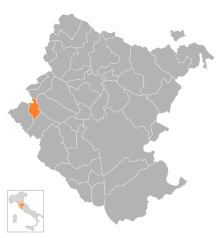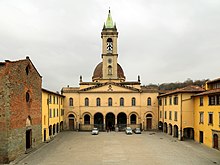San Giovanni Valdarno
| San Giovanni Valdarno | ||
|---|---|---|

|
|
|
| Country | Italy | |
| region | Tuscany | |
| province | Arezzo (AR) | |
| Coordinates | 43 ° 34 ' N , 11 ° 32' E | |
| height | 134 m slm | |
| surface | 21.32 km² | |
| Residents | 16,847 (Dec. 31, 2019) | |
| Population density | 790 inhabitants / km² | |
| Post Code | 52027 | |
| prefix | 055 | |
| ISTAT number | 051033 | |
| Popular name | Sangiovannesi | |
| Patron saint | San Giovanni Battista (June 24th) | |
| Website | San Giovanni Valdarno | |
 San Giovanni Valdarno |
||
San Giovanni Valdarno is an Italian municipality with 16,847 inhabitants (as of December 31, 2019) in the province of Arezzo in Tuscany .
geography
The municipality of San Giovanni Valdarno is located in the Arno Valley and consists of the districts Badiola-Renacci, Gruccia, Borro al Quercio, Ponte alle Forche, Porcellino, Pruneto and Montecarlo.
The neighboring municipalities are Castelfranco Piandiscò , Cavriglia , Figline e Incisa Valdarno ( FI ), Montevarchi , and Terranuova Bracciolini .
history
San Giovanni Valdarno was re-established from 1296 under the name "Castel San Giovanni" by the Commune of Florence as a so-called Terra nuova (fortified new town). The place served to secure the border between the Republic of Florence and its neighbor Arezzo upstream of the Arno, as well as a fortified marketplace and customs post on the pilgrimage and trade route Via Cassia to and from Rome , about a day's journey from the mother city .
Urban significance
The Castel San Giovanni was the prototype of a series of five new town foundations by the municipality of Florence, which, from the turn of the 14th century, pursued the goal of fortifying the still young territorial state on its periphery. In the following years until 1348, Castelfranco di Sopra (Valdarno), Scarperia (Mugello), Firenzuola (Apennines) and Terranuova Bracciolini (Valdarno) were founded according to the same type.
The urban planning type of these medieval planned cities is characterized in particular by the strictly right-angled city floor plans , which are spanned symmetrically around a central longitudinal axis. The mostly rectangular (San Giovanni, Scarperia, Terranuova), sometimes almost square (Castelfranco di Sopra, Firenzuola) "castles" were surrounded by a city wall with towers . The gate towers, which today only survived in individual cases in the medieval substance, were each located in the middle of the four walls, were specially dedicated to patron saints and cited the architectural forms of the gates of the mother city of Florence as stately landmarks.
The center of the city always takes market square, to, or for which a municipal palace was built to the Office of the employed by the parent community governors ( Vicari to host). The rural population of the respective region was obliged to build the cities - with the granting of temporary tax privileges - who also formed the later urban population. The orthogonal street grid and the dimensioning of the strip parcels embedded in it, as well as the building volumes built on it according to uniform design specifications, suggest a planning process in which strict geometric construction principles were applied in order to create a hierarchically ordered urban body as the social topography of a newly urbanized population. Through the Free Art of Geometry , the city was given a "godly" form that cited contemporary ideas of the Heavenly Jerusalem .
The construction principles can be integrated into a rich frame of reference for urbanistic theories of the Middle Ages and Roman antiquity using scholastic textbooks on geometry (e.g. Liber abbaci des Fibonacci ) and theological and state-theoretical sources ( Thomas von Aquin , De civitate Dei des Augustine , Vitruvius ) put. So far hardly any research has been carried out on suspected references to the Corpus agrimensorum Romanorum . Since Giorgio Vasari ( Vite ) until today, the urban design has been attributed to the sculptor and architect Arnolfo di Cambio , after whom the communal palace ( Palazzo d'Arnolfo ) is popularly named.
The urban planning type of the Florentine terra nuova is closely related to the French bastides of the 13th century (e.g. Aigues-Mortes ). This stylistic line of influence finds its political counterpart in the contemporary alliance of the French royal house of the Capetians with the papacy . Another formal predecessor of Terre nuove is the city of Pietrasanta, founded in 1255 .
It is controversial in research to what extent the Florentine Terra nuova , and in particular San Giovanni Valdarno as their prototype, can be regarded as early ideal cities or as precursors of the ideal cities of the Renaissance .
Attractions
- Palazzo d'Arnolfo , 12th century , named after Arnolfo di Cambio
- Basilica di Santa Maria delle Grazie , basilica built in 1484
- Chiesa della Santissima Annunziata , church and monastery since 1528
- Chiesa di San Lorenzo , church
- Chiesa di Santa Lucia , church
- Pieve di San Giovanni Battista , Pieve , originated in 1312
- Convento di San Francesco a Montecarlo , monastery built in 1424 in the località Montecarlo
Sports
The local soccer club AC Sangiovannese 1927 currently plays in the fourth-class Lega Pro Seconda Divisione .
Town twinning
San Giovanni Valdarno is twin town of:
Sons and daughters of the church
- Mariotto di Cristofano (1395–1457), painter
- Tommaso di ser Giovanni, called Masaccio (1401–1428), painter, pupil of Masolino da Panicale
- Giovanni di ser Giovanni, called Lo Scheggia (1406–1486), painter, brother of Masaccio
- Giovanni Mannozzi, called Giovanni da San Giovanni (1592–1636), painter
- Francesco Feroci (1673–1750), composer and musician, first organist at the Florence Cathedral
- Nicolau Nasoni (1691–1773), painter and architect
- Mario Salmi (1889–1980), art historian, art critic and academic
literature
- David Friedman: Florentine New Towns: urban design in the late Middle Ages . MIT Press, Cambridge / Mass. 1988, ISBN 0-262-06113-9 .
- Guidoni, Enrico (ed.): Arnolfo di Cambio urbanistà . Buonsignori, Rome 2003, ISBN 88-7597-330-X .
- Maria Teresa Bartoli u. a. (Ed.): Città e Architettura: Le Matrici di Arnolfo . Edifir, Florence 2003, ISBN 88-7970-189-4 .
- Emanuele Repetti: SAN GIOVANNI, già S. GIOVANNI IN ALTURA e innanzi CASTEL DI PIAN ALBERTI nel Val d'Arno superiore. In: Dizionario Geografico Fisico Storico della Toscana (1833–1846), online edition of the University of Siena (pdf, ital.)
- Touring Club Italiano : Toscana. Milan 2003, ISBN 88-365-2767-1 , pp. 779 ff.
Web links
- City homepage (Italian)
- Homepage for exhibitions on the occasion of the 700th anniversary of Arnolfo di Cambio's death (Italian)
Individual evidence
- ↑ Statistiche demografiche ISTAT. Monthly population statistics of the Istituto Nazionale di Statistica , as of December 31 of 2019.
- ↑ Guidoni, Enrico (ed.): Arnolfo di Cambio urbanistà . Buonsignori, Rome 2003, ISBN 88-7597-330-X .
- ^ David Friedman: Florentine New Towns: urban design in the late Middle Ages . MIT Press, Cambridge / Mass. 1988, ISBN 0-262-06113-9 .
- ^ Maria Teresa Bartoli u. a. (Ed.): Città e Architettura: Le Matrici di Arnolfo . Edifir, Florence 2003, ISBN 88-7970-189-4






